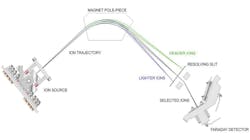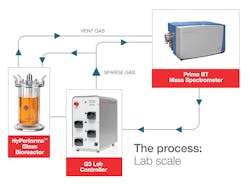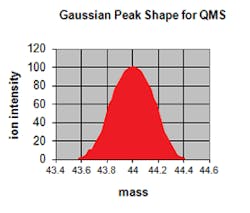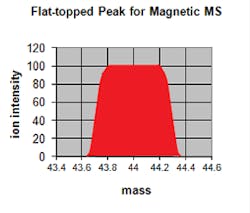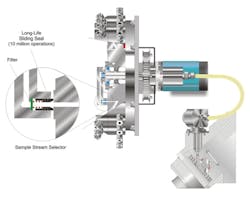The fermentation process plays an important role in biotechnology, producing a wide range of key products in a variety of industries, including antibiotics, vaccines, biofuels, industrial enzymes, food additives and vitamins. Fermentation systems can be batch, fed batch and continuous. Many fermentations are characterized by small changes in oxygen and carbon dioxide concentrations at critical phases of the process, such as the lag phase when the microorganisms exist in equilibrium with the nutrients.
Even small changes in these concentrations can have a significant impact on the quality, safety and consistency of the final biotherapeutic. It is therefore essential that the method used to monitor these gases is highly precise and reliable, in order to maintain the optimum manufacturing environment throughout the entire fermentation process.
Real-time analysis of oxygen, carbon dioxide and volatile gases is ideal as a quality control step for this application, accurately tracking a culture’s growth kinetics and substrate consumption non-invasively, without compromising the sterile environment. Gas analysis involves the precise evaluation of the component concentrations of the bioreactor’s inlet and outlet gases. Oxygen, carbon dioxide, nitrogen and argon must be measured to calculate the respiratory quotient (RQ), the rate of O2 consumption, and the rate of CO2 evolution, with a high RQ value indicating a highly efficient metabolism.
The results of gas analysis therefore inform process optimization, feed times and the start of induction, and allow operators to determine the best point at which to halt fermentation for maximum visible cell mass. Gas analysis additionally improves overall manufacturing efficiency by reducing over processing and waste, as well as pinpointing contamination prior to inoculation, and the onset of poisoning. These factors ultimately contribute significantly to higher biopharmaceutical yields and profits.Why magnetic sector-based mass spectrometry?
The speed and precision of mass spectrometry (MS) makes it the first choice for the real-time monitoring of fermentation and cell culture off-gas. Process mass spectrometers have many benefits, such as being highly accurate, robust and versatile. They are also very low maintenance and are self-calibrating, avoiding the downtime common with other analytical methods and allowing continuous use. Mass spectrometers are much more flexible than alternative gas analyzers because their analytical methods are mainly defined in the software. This allows MS to analyze a wide range of sample streams with widely different compositions, and enables analytical methods to be easily modified.Two types of mass spectrometer have been used to monitor fermentation processes: magnetic sector-based, where charged particles are separated in a variable magnetic field; and quadrupole, where charged particles are separated in a variable radiofrequency field. Magnetic sector technology possesses numerous advantages over its quadrupole counterpart and has demonstrated the highest performance for on-line gas analysis. It has high selectivity and accuracy, and analytical precision up to 10 times better than a quadrupole mass spectrometer, depending on the gases analyzed and complexity of the mixture. The laminated magnet enables consistently high scanning speeds, resulting in very frequent data acquisition.
Another strength of magnetic sector-based MS is that it uses high-ion acceleration voltage to produce high-energy ions, reducing its susceptibility to scattering by residual molecules (contamination) in the vacuum system. This enables the analyzer to operate uninterrupted for long periods without needing mass filter cleaning, and to achieve excellent stability for low molecular weight compounds, such as hydrogen and helium. Magneticsector-based mass spectrometers are additionally less influenced by space charge or surface charging effects due to imperfect electrode surfaces, which can cause misalignment or drift in the mass axis. This means that the signal intensity at any specific mass position appears as a flat-top peak, negating the need to measure the exact middle of the peak and making the platform intrinsically fault tolerant. The resistance to contamination allows magnetic sector-based mass spectrometers to have long intervals between calibrations, which is extremely valuable for lengthy fermentation processes.In contrast, quadrupole MS uses a significantly lower ion energy, so ions are more easily deflected by contamination build-up, resulting in lower precision. Since quadrupole MS produces a rounded Gaussian peak shape, this means that these instruments are susceptible to drift in the mass scale and peak height measurement as a result of gradual contamination. This mass drift must be corrected by more frequent calibration, taking up valuable production time. The contamination will also eventually need to be removed, with far shorter intervals between cleanings if the sample streams contain high levels of hydrocarbons.
Boosting productivity with multi-stream analysis
MS systems that are used to monitor multiple bioreactors require a fast, reliable means of switching between streams. Unfortunately, typical solenoid valve manifolds have excess dead volume, and rotary valves suffer from poor reliability.
Rapid multistream samplers (RMS) offer an unmatched combination of sampling speed and reliability, and the most advanced models are now able to process up to 64 streams. Stream switching times are application dependent and completely user configurable, and the software’s stream status keeps the user informed of the analysis. These RMS modules also include a digital sample flow recording for every selected stream, which can be used to trigger an alarm if the sample flow drops. Samplers may be heated to +120 °C (+248 °F) which, together with a heated ion source of specially selected materials, ensures a fast response to polar species such as methanol, ethanol and other volatiles. This makes it possible to measure these species with high precision at concentrations as low as 10ppm.
The future of biopharma manufacturing
There is undoubtedly a great need for reliable and high performance real-time gas analysis in the biopharmaceutical industry. Fortunately, MS technology has advanced dramatically and rapidly over the last two decades, with innovative and intuitive devices being brought to the market at record speed.
Magnetic sector-based MS systems display the highest levels of precision for fermentation off-gas monitoring and analysis, and have been successfully used at many of the world’s leading biotechnology and pharmaceutical companies for several decades. These analyzers combine high speed with excellent stability to provide reproducible quantitative measurements of bioreactor headspace gases. These tools therefore enable manufacturers to improve the cost-effectiveness and yield of their fermentation processes, enlarging their capacity to meet the growing demand for both quantity and quality.
